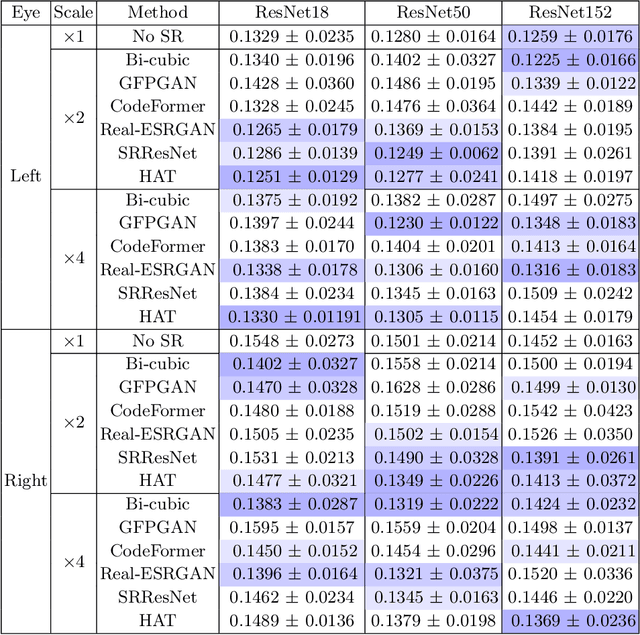Vijul Shah
Webcam-based Pupil Diameter Prediction Benefits from Upscaling
Aug 19, 2024



Abstract:Capturing pupil diameter is essential for assessing psychological and physiological states such as stress levels and cognitive load. However, the low resolution of images in eye datasets often hampers precise measurement. This study evaluates the impact of various upscaling methods, ranging from bicubic interpolation to advanced super-resolution, on pupil diameter predictions. We compare several pre-trained methods, including CodeFormer, GFPGAN, Real-ESRGAN, HAT, and SRResNet. Our findings suggest that pupil diameter prediction models trained on upscaled datasets are highly sensitive to the selected upscaling method and scale. Our results demonstrate that upscaling methods consistently enhance the accuracy of pupil diameter prediction models, highlighting the importance of upscaling in pupilometry. Overall, our work provides valuable insights for selecting upscaling techniques, paving the way for more accurate assessments in psychological and physiological research.
EyeDentify: A Dataset for Pupil Diameter Estimation based on Webcam Images
Jul 15, 2024



Abstract:In this work, we introduce EyeDentify, a dataset specifically designed for pupil diameter estimation based on webcam images. EyeDentify addresses the lack of available datasets for pupil diameter estimation, a crucial domain for understanding physiological and psychological states traditionally dominated by highly specialized sensor systems such as Tobii. Unlike these advanced sensor systems and associated costs, webcam images are more commonly found in practice. Yet, deep learning models that can estimate pupil diameters using standard webcam data are scarce. By providing a dataset of cropped eye images alongside corresponding pupil diameter information, EyeDentify enables the development and refinement of models designed specifically for less-equipped environments, democratizing pupil diameter estimation by making it more accessible and broadly applicable, which in turn contributes to multiple domains of understanding human activity and supporting healthcare. Our dataset is available at https://vijulshah.github.io/eyedentify/.
 Add to Chrome
Add to Chrome Add to Firefox
Add to Firefox Add to Edge
Add to Edge